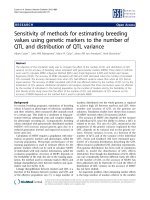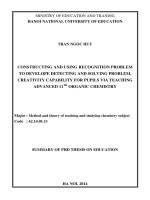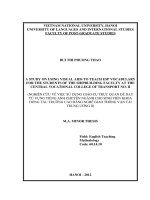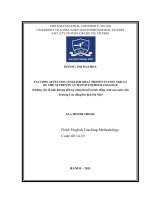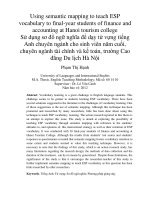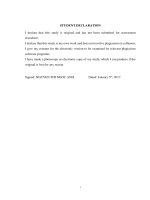USING SEMANTIC MAPPING TO TEACH ESP VOCABULARY TO FINAL-YEAR STUDENTS OF FINANCE AND ACCOUNTING AT HANOI TOURISM COLLEGE
Bạn đang xem bản rút gọn của tài liệu. Xem và tải ngay bản đầy đủ của tài liệu tại đây (947.65 KB, 71 trang )
VIETNAM NATIONAL UNIVERSITY, HA NOI UNIVERSITY
OF LANGUAGES AND INTERNATIONAL STUDIES
FACULTY OF POST-GRADUATE STUDIES
PHẠM THỊ HẠNH
USING SEMANTIC MAPPING TO TEACH ESP VOCABULARY TO
FINAL-YEAR STUDENTS OF FINANCE AND ACCOUNTING
AT HANOI TOURISM COLLEGE
(Sử dụng sơ đồ ngữ nghĩa để dạy từ vựng tiếng Anh chuyên ngành cho sinh
viên năm cuối, chuyên ngành tài chính và kế toán, trường Cao đẳng Du lịch
Hà Nội)
M.A MINOR THESIS
Field: English Teaching Methodology
Code: 60.14.10
HANOI – 2012
iv
TABLE OF CONTENTS Page
Declaration i
Acknowledgements ii
Abstract iii
Table of contents iv
List of abbreviations vii
List of tables vii
PART A: INTRODUCTION
1. Rationale of the study 1
2. Aims and objectives of the study 2
3. Scope of the study 2
4. Research questions 3
5. Significance of the study 3
6. The method of the study 4
7. Design of the study 4
PART B: DEVELOPMENT
CHAPTER 1: LITERATURE REVIEW
1.1 What is vocabulary? 6
1.2. The role of vocabulary in second language learning 6
1.3. What is involved in teaching L2 vocabulary 8
1.4. Challenges of L2 vocabulary learning 8
v
1.5. The nature of ESP vocabulary 9
1.6. Challenges of ESP vocabulary learning 11
1.7. What should be taught in ESP vocabulary teaching 12
1.7.1. Word form 12
1.7.2. Word formation 12
1.7.3. Word relations 13
1.7.4. Collocation 14
1.8. Characteristics of financial & accounting English vocabulary 14
1.8.1. The morphological characteristics 14
1.8.2. The semantic characteristics 15
1.9. Vocabulary retention 16
1.10. Semantic mapping as a vocabulary instruction strategy 16
1.10.1. Definitions of semantic mapping 16
1.10.2. Procedures to construct a semantic map 17
1.10.3. Previous studies of the impact of semantic mapping on students‟ vocabulary
learning 19
Benefits of semantic mapping 19
Limitations of semantic mapping 23
CHAPTER 2: THE STUDY
2.1. The context of the study 25
2.1.1. Research setting 25
2.1.2. Teaching materials 26
vi
2.2. Research participants 26
2.3. Data collection instruments 27
2.3.1. Tests 27
2.3.2. Questionnaire 28
2.4. Treatment procedures 29
2.5. Procedures of data collection 31
2.6. Data analysis 31
CHAPTER 3: FINDINGS AND DISCUSSION
3.1. Findings 32
3.1.1. The effectiveness of semantic mapping on students‟ word retention 32
3.1.2. Students perceptions of the benefits of semantic mapping to their word retention.
34
3.2. Discussion. 36
PART C: CONCLUSION
1. Summary of the study 38
2. Limitation of the study and suggestions for further study 40
REFERENCES
APPENDICES
vii
LIST OF ABBREVIATIONS
GE: General English
ESP: English for specific purpose
HTC: Hanoi Tourism College
L2: The second language
LIST OF TABLES
Table 3.1. Students‟ test scores in three progress tests
33
Table 3.2.: Students‟ perceptions of the benefits of semantic mapping to
their ESP vocabulary learning
34
1
PART A: INTRODUCTION
1. Rationale of the study.
In recent years, the demand for learning English for specific purpose
(ESP) has been spread nationwide. Due to the social needs, ESP is taught in
almost universities, colleges and vocational schools. Most of English
departments offer courses in ESP after General English (GE) during the basic
years. Hanoi Tourism College (HTC) is a typical example of the training
institutions that combines ESP within its current English teaching situation in
response to the demand for specific language learning target. In Hanoi Tourism
College, teachers are required to teach English to students from various fields
such as Restaurant, Hotel, Travel agency, Tour guiding, Finance and accounting,
and food production.
One of the concerns about the ESP program at the College is how to help
students learn the ESP vocabulary better. This is really critical given the role of
vocabulary in second language learning either for General Purposes or for
Specific Purposes. Many scholars have considered vocabulary acquisition as
being fundamental and crucial component to any foreign language learners.
Wilkins (1972, p.11) emphasizes the importance of vocabulary as “without
grammar, very little can be conveyed, without vocabulary, nothing can be
conveyed”. For ESP, Robinson (1991), pointed out that for many people,
vocabulary, particularly specialist vocabulary (or terminology), is the key
element of ESP.
At HTC, despite teachers‟ efforts to try experimenting various vocabulary
techniques, the result is far from satisfaction. Students still have serious
2
difficulties memorizing, recalling and using specialist vocabulary, i.e.,
vocabulary related to their field of finance and accounting. The desire to help
students address these difficulties motivate me to carry out this study, which is
aimed at exploring the possibility of using the semantic mapping strategy to
teach ESP vocabulary. This teaching technique has not been used at HTC to the
best of my knowledge.
2. Aims and Objectives of the Study
The aim of the study is to explore the possibility of teaching ESP
vocabulary through semantic mapping with reference to the students‟ attitudes
to, and opinions of, this instructional strategy as well as their retention of ESP
vocabulary. Because it is just a stepping stone to the extensive application of the
semantic mapping strategy to teach ESP vocabulary, it is confined to two
following objectives:
- To investigate students‟ perceived benefits of learning ESP vocabulary
through semantic mapping?
- To examine the impact of employing semantic mapping on students‟
ESP vocabulary retention.
3. Scope of the study
Firstly, the study limits itself to the investigation of the students‟
perceptions of the usefulness of semantic mapping to their ESP vocabulary
learning as well as their retention of ESP vocabulary as measured by the
questionnaire responses and progress tests. Secondly, this study is similar to a
small-scale action research project in the sense that its primary purpose is to help
3
the researcher to improve her teaching. Therefore, the study was conducted with
the final-year participant students of three year-training program who were real
students in the researcher‟s class. Finally, the study used the the textbook named
“English for finance and accounting” which was compiled by teachers from HTC
and is in use at the college as instructional material.
4. Research questions
In order to achieve the aim and objectives of the study, the following
research questions are formulated:
1. What are students’ perceived benefits of learning ESP vocabulary
through semantic mapping?
2. To what extent does semantic mapping help students learn ESP
vocabulary better as measured by their retention of vocabulary ?
5. Significance of the study
Although semantic mapping has been researched extensively in the
context of second language vocabulary learning, little research has been done in
ESP. Although this study focuses only on the students‟ perceived benefits of
semantic mapping to their ESP vocabulary and the impact of this vocabulary
technique on their ESP vocabulary retention, the findings of this study will shed
more light on the possibility of using semantic mapping to teach ESP
vocabulary. These findings can also lay the foundation for a more extensive
study on the impact of this vocabulary strategy upon students‟ ESP vocabulary
acquisition in the context where ESP is taught as a minor subject.
4
6. Methods of the study
Since the purpose of the study is to test the impact of semantic mapping on
students‟ ESP vocabulary aquisition, a quasi- experimental design is appropriate.
The study is quasi-experimental in two ways. Firstly, no randomized sampling
was used; instead an intact group of students were used in this study. Second, the
study design did not use the pretest-posttest design (Nunan, 1992). Instead, the
impact of the treatment was measured through progress tests and a final test. In
addition to these tests, a student questionnaire was also employed.
In order to obtain information for the two research questions stated in
Section 4 above, two main instruments of data collection were used: the student
questionnaire and the progress tests. Because the first research question is to find
out students perceptions of the treatment, the student questionnaire was designed
and administered to the students at the end of the treatment to obtain their
responses to the treatment. Regarding to the second research question, two
progress tests and a final test, which was administered at the end of the
treatment, were used to measure the students‟ retention of the taught vocabulary
under the influence of the treatment.
7. Design of the study
The thesis is composed of three parts.
Part A – the Introduction – introduces the rationale, the aims and
objectives, the scope, the research questions, the significance, the method, and
the design of the study are presented.
5
Part B - the Development – consists of three chapters, and is the backbone
of the thesis. Chapter 1 provides the theoretical framework for the study. This
framework provides the guidelines for conducting this research and for the
discussion of the data. Chapter 2 provides the information about the context in
which the study was conducted, the research participants, and the research
procedures including experiment, the methods of data collection and data
analysis. The findings of the study are presented and discussed in Chapter 3.
Part C: Conclusion -the major findings are summarised with reference to
the research questions mentioned in section 4 of the Part A. Also in this Part are
the acknowledgement of the limitations of the study, the implications for
teaching ESP vocabulary using the semantic mapping and suggestions for
further study.
PART B: DEVELOPMENT
CHAPTER 1: LITERATURE REVIEW
In this chapter, the literature on vocabulary teaching and learning, and the
use of semantic mapping as a technique of teaching vocabulary will be reviewed.
The chapter starts with a definition of vocabulary and the importance of
vocabulary in second or foreign language learning in general and in learning
English for specific purposes (ESP) in particular. Then, a review of what is
involved in teaching foreign language vocabulary as well as the challenges of
learning vocabulary will be presented. This provides a background for the next
sections which focus on the linguistic features distinctive of ESP vocabulary and
what makes teaching and learning ESP vocabulary challenging. In addition to
6
these, some other basic issues related to ESP vocabulary teaching and learning
are presented and discussed. Finally, previous studies on using semantic
mapping for teaching vocabulary are reviewed.
1.1. What is vocabulary?
Up to now there are different definitions of vocabulary. Each linguist
gives his/her own definition of vocabulary depending on the different criteria
that he/she considers the most important factors in terms of linguistics,
semantics, lexicology, etc.
Hornby (1995, p.1331) states that vocabulary is the total number of words
which ( with rules of combining them) makes up a language. Similarly, Ur
(1996) defines vocabulary as “the words we teach in the foreign language” (p.
60). She adds that a new item of vocabulary may be more than a single word: a
compound of two or three words or multi-word lexical units or idioms. These
multi-word lexical units are a challenge to foreign language learners because
their meaning can not be deduced from an analysis of component words.
Example of this vocabulary class are balance sheet, current account, write-off,
financial records, etc.
For the purpose of this study, vocabulary is understood as the total number
of all the words that a language possesses. It is not only simple words, but also
complex and compound words, creating the meaningful units of language.
1.2. The role of vocabulary in second language learning
It is commonly accepted that vocabulary is one of the fundamental
elements of a language. Pyles and Algeo (1970) states
7
When we first think about language, we think first about
words. It is words that we arrange together to make sentences,
conversations and discourses of all kinds. (p.96)
As words are the meaningful units of a language, vocabulary is of critical
importance to L2 learners. This is highlighted by McCarthy ( 1990), who argues,
No matter how well the students learns grammar, no matter
how successfully the sounds of L2 are mastered, without words to
express a wider range of meanings, communication in an L2 just
cannot happen in any meaningful way. (p. 8)
It can be inferred that if the primary goal of foreign language learning is
communication, vocabulary should be given special attention. If the learner has a
wide range of vocabulary with little grammar, he or she can not only make
himself or herself understood but also understand the language easily. On the
contrary, if the learner‟s vocabulary is limited with much knowledge of
grammar, he or she can find it very difficult to communicate or to understand the
language. Laufer (1998) is right in noting “ the most striking differences between
foreign learners and native learners is in the quantity of words each group
possesses” (p. 225) . Emphasizing the need to constantly expand the vocabulary,
Thornbury (1997) advices foreign language learners that they should try to
expand their vocabulary continuously because vocabulary acquisition is a never-
ending process.
In reality, vocabulary directly link to language skills as listening,
speaking, reading and writing. Therefore, a good vocabulary knowledge
facilitates second language learners‟ comprehending the text they are reading or
8
listening, enable learners to speak naturally and to write professionally.
Obviously, there is no way of making advance in second language without
efforts to increase vocabulary.
1.3. What is involved in teaching L2 vocabulary
According to Harmer (1991, p. 158), to know the word involves knowing
its:
Meaning (its definition) - meanings in context, sense relations (synonyms,
antonyms, hyponyms)
Usage – collocations, idioms and metaphors, style and register
Form – spelling and pronunciation, prefixes and suffixes, parts of speech
Grammar – irregular forms, phrasal verbs, adverbs and adjectives
Because of this complexity of vocabulary knowledge, it is really
challenging to teach and learn L2 vocabulary. These challenges are discussed
in the following section.
1.4. Challenges of L2 vocabulary learning
As mentioned above, vocabulary learning is a complex process. According
to scholars (e.g. Jensen, 1998; Sprenger,1999), one of the most difficulties that
foreign language students is likely to be encountered is retaining words
retrieving their meanings for communicative use. This difficulty may be related
to inadequate initial information processing which results in words having a poor
"network of associations". Therefore, in order to help learners to deal with this
problem, foreign language teachers have to consider ways of deepening the
associations and the semantic connections of the target vocabulary so as to
9
ensure accurate long term storage. Towards this goal, semantic mapping can be a
good teaching strategy.
Because this study aims to investigate the potential advantages of semantic
mapping as a strategy of teaching ESP vocabulary, it would be helpful to look
into the distinctive features of ESP vocabulary.
1.5. The nature of ESP vocabulary
Vocabulary plays a key role in learning foreign languages in general and
in professional course in particular. ESP vocabulary is classified into different
categories: semi-technical vocabulary/ sub-technical vocabulary, and technical
vocabulary or jargons.
Sub-technical vocabulary: Sub-technical words are most frequent in ESP
vocabulary. Inman (cited in Kennedy & Bolitho, 1984, p.58) notes that sub-
technical vocabulary seems to be involved in almost 80 per cent of scientific
texts that is a quite high occurrence. These are “words that have one or more
´general´ English meanings and which in technical contexts take on extended
meanings (technical, or specialized in some fashion)” (Trimble, 1985, p. 129).
According to Kennedy and Bolitho (1984), sub-technical words are “words
which are not specific to a subject specialty but which occur regularly in
scientific and technical texts” (p.57-58). This feature may lead to
misunderstanding of the meaning of ESP words by those who neither have the
relevant specialized knowledge nor sufficiently good English. In addition, it
often represents a problem for both the learner and the teacher who lack relevant
knowledge of the field. Consequently, it is the sub-technical lexis that teacher
should give high priority when teaching ESP vocabulary.
10
Technical vocabulary: Unlike semi-technical vocabulary, technical
vocabulary are words “ recognizably specific to particular topic, field or
discipline” (Nation 2001, p.198). Technical vocabulary is most obviously
associated with specialized texts or discourse. These words have their specific
meanings and they seem to be very uncommon to the people who are not related
to their fields of meaning (Fraser 2005). Technical vocabulary can be sub-
divided into three smaller categories:
Fully technical vocabulary
Crypto technical vocabulary
Lay-technical vocabulary
Fully technical vocabulary comprises those words whose meaning is
clearly technical. They are specific to the field and not likely to be known in
general language e.g: hypertension, obesity, hepatitis, … Crypto technical
vocabulary consists of polysemous words like “transmitter” which could be said
to be „cryptic” in that they have a hidden technical meaning. Lay-technical
vocabulary comprises those terms which are obviously technical but are likely to
be known by the layperson.
In summary, ESP vocabulary falls into two broad categories: semi-
technical and technical. This means that in learning ESP, students have to cope
with these two categories plus general vocabulary or non-technical vocabulary.
However, the semi-technical vocabulary tends to outnumber the technical
vocabulary. This is really a challenge to students whose English is limited. These
students are likely to misunderstand or get confused about the meaning of the
words. Thus, it is more difficult for them to retain words that they have been
11
taught. According to Nation (2001, p.187), “It is wise to direct vocabulary
learning to more specialized areas when learners have master words of general
usefulness in English” (Nation, 2001, p.187). This seems that semantic mapping
can be an effective technique of ESP vocabulary teaching. This technique allows
teachers to elicit students‟ words of general usefulness before helping them to
link these words with the ESP contexts through the process of semantic
mapping. The pros and cons of this vocabulary technique will be are discussed
later in this chapter.
1.6. Challenges of ESP vocabulary learning
The first thing to realize about ESP vocabulary items is that they
frequently have more than one meaning which cause troubles for most learners.
The second is that ESP words are perceived as more complex than general words
due to the fact that collocation is very frequent in ESP. (Xhaferi, 2010, p. 236).
Compound nouns in ESP in terms of its form and meaning is the factor
challenging students since longer words should be more difficult to learn and
remember and their meanings are not simply deduced from their parts. Trimble
(1985, p.131, 163) points out that understanding and producing noun compounds
makes problems for many non-native students. Some examples of compounds
given below will show that they themselves are the problems for anyone
learning, reading, and translating a financial and accounting text: dormant
account, liquid asset, baby bond, red-chip company and so on.
Consequently, the primary concern for ESP teachers, apart from deciding
what words should be taught or given priority, is helping learners familiar with
ESP collocations as compounds.
12
1.7. What should be taught in ESP vocabulary teaching
It is word form, meaning and use that should be focused on in ESP
vocabulary teaching. Consequently, Kennedy and Bolitho state that “the study of
word formation and word relationships” (1984, p.59), or sense relations,
constitutes the two important aspects of teaching ESP vocabulary. Besides,
Penny Ur (1996) added word form and collocation.
1.7.1. Word form
Vocabulary cannot be taught or learnt in complete isolation from the rest
of linguistics components namely grammar, phonetics and phonology. The
learner has to know what the word sounds like (its pronunciation) and what it
looks like (its spelling) when learning vocabulary. This can be particularly
problematic for learners of English because there is often no clear relation
between how a word is written and how it is pronounced. It is very important to
use the phonemic script in such cases so the students have clear written record of
the pronunciation. The teacher needs to make sure that these aspects are
accurately presented and learnt
1.7.2. Word formation
Students should be taught the common prefixes and suffixes and how they
work, For example, if learners know the meaning of "in", "de" and "il", or “able”
this will help them guess the meaning of words such as "intangible",
"deregulation", and "illegal" or “ payable”. However, students should be warned
that in many common words the affixes no longer have obvious connection with
their root meaning (for example: "consider" -> "considerable")
13
Another way vocabulary items are built is by combining two words: two
nouns, or a gerund and a noun, or a noun and a verb to make one item: a single
compound word or two separate (for example: "book list"," sitting room")
1.7.3. Word relations
Word relations is very useful in vocabulary teaching and learning. They
show how the meaning of one item relates to the meaning of others. Kennedy
and Bolitho stress that “words do not exist in isolation” (1984, p.62) and so they
should be taught in context. Gairns and Redman, (1986, p.22) also emphasizes
that “the meaning of a word can only be understood and learnt in terms of
relationship with other words in the language” or “words are not learnt
mechanically, as little packets of meaning, but associatively” (Morgan &
Rinvolucri, 2004, p.7). In order to understand word relationships, learners should
do activities involving synonyms (words with similar meaning), antonyms
(words with opposite meaning), hyponyms (subordinates), co-hyponyms (co-
ordinates) and hypernyms (super-ordinates) and collocations. These activities
can be included in vocabulary teaching strategies as diagrams, mind maps, word
trees which group words by categories (building materials: stone, sand, wood),
by word families (to build, builder, building), by topic (at a building site).
According to Gairns and Redman (1986) these strategies are considered the
most effective and favorite strategies in ESP vocabulary teaching because
“organization is the key to memory, this is an important part of teaching your
students how to be efficient learners” (p.100).
14
1.7.4. Collocation
A collocation is an expression consisting of two or more words that
correspond to some conventional way of saying things. Or in words of Firth
(1957) “collocations of a given word are statements of the habitual or customary
places of that word” (p.181). It refers to the restrictions on how words can be
used together in right contexts. We can talk about “thick fog” and “dense fog”
with the same meaning. However, we cannot say “dense hair” instead of “thick
hair”.
It seems that word form, word formation, word relations or collocation can
be taught through semantic mapping
1.8. Characteristics of financial and accounting English vocabulary
According to the study by Nguyen Phuoc Vinh Co and Bui Kim Yen
(2011), financial and accounting English vocabulary has the morphological and
semantic characteristics as following.
1.8.1.The morphological characteristics
Morphologically, English words of finance and accounting can be simple
words, compound words, and phrases with either pre-modifiers and post-
modifiers.
Simple words: financial, accounting English vocabulary appears many
simple words such as „asset‟, „bear‟, „capital‟, „debit‟, „earnings‟.
Compound words: According to Nguyen and Ton (2010) cited in study
by Vinh Co and Kim Yen, collocations, especially, noun plus nouns and
adjective plus nouns are one of the most characteristic features of financial and
15
accounting English vocabulary. The corpus of the collocations of compound
nouns in „Longman Business Dictionary‟ given by these two authors shows that
the word „account‟ has 65 collocations; „asset‟ has 13 collocations; „balance‟ has
14 collocations and so on.
Besides, some compounds consisting of verb + preposition also add to the
terminology of financial and accounting English such as „buy-back‟, „buy-in‟,
„take-out‟, „take-over‟, „turn-over‟, „write-down‟, „write-off‟ and so on.
Phrases with premodifers or post-modifiers: Another common
characteristics in financial and accounting terminology is premodified and
postmodified noun phrases. The long premodified noun phrases are as in „public
sector borrowing requirement‟, „accounts receivable turnover‟, etc., Besides
them, we also see the long postmodified noun phrases as in „law of diminishing
returns‟, „return on capital employed‟, „balance brought down‟, so on.
1.8.2. The semantic characteristics
In terms of semantics, English vocabulary of finance and accounting can
be classified broadly into two categories: (a) general words with specialized
senses, and (b) words with highly specialized meaning, i.e., compounds whose
meanings are not inferred by adding the meaning of components together.
Firstly, the most basic characteristic is that general English words have
specialized senses. We will come across these terms in a financial and
accounting text such as „asset‟, „balance‟, „capital‟, „earnings‟, „gain‟,
liabilities, and many other terms. It is worth noting that these terms, when
combining with other terms, usually give us a collocation pattern that may sound
16
odd in everyday English but is common collocations in financial and accounting
English.
Regarding to the second category, Quirk & et al. (1980) (cited in Cố and
Yến 2011) note that semantically, compounds can be seen to be isolated from
ordinary syntactic constructions by having a meaning which may be related to
but can not simply be inferred from the meaning of its parts such as “deposit
account”, “current account”, “demand account” etc.
1.9. Vocabulary Retention
Retention is defined as "an ability to recall or recognize what has been
learnt or experienced; memory" (Oxford Advanced Learner's Dictionary (1992,
p.773). Although no definition of vocabulary retention has been found in
literature review by the researcher, for purpose of her study, she can state that
vocabulary retention is the storage of vocabulary in the memory, which becomes
available for use when needed. So retention of vocabulary is ability to recall
words that have been learnt for communicative use.
1.10. Semantic mapping as a vocabulary instruction strategy
1.10.1. Definitions of semantic mapping
Semantic mapping, a strategy popularly used in foreign language
instruction, is up to now defined by many scholars and researchers.
Semantic mapping is defined “ a visual representation of knowledge, a
picture of conceptual relationship” (Antonacci, 1991, p.174) or “ a graphic
arrangement showing the major ideas and relationships in text or among word
meanings” (Sinatra, Stahl-Gemake, & Berg, 1984, p. 22). According to Stoller
17
(1994), semantic mapping is a “ graphic display of information within categories
related to central concepts” creating associative networks for words. Sharing the
points with Stoller, Johnson, Pittelman, and Heimlich (1986) notes that semantic
mapping is a “ categorical structuring of information in graphic form” (p.779). It
is an individualized content approach in that students are required to relate new
words to their own experiences and prior knowledge. Defining in a simple way,
semantic mapping is the building up of “ a diagrammatic maps showing the
relationship between vocabulary suggested by teachers, suggested by learners
and found in a reading text” (Nation 1990, p.129). In short, semantic mapping is
the process of creating a graphic map, in which the new knowledge is integrated
in the old and words or concepts or ideas are represented in categories and
semantic relationship among them is visually shown.
1.10.2. Procedures to construct a semantic map
Semantic mapping may be presented in a variety of ways. Johnson and
Pearson (1984) cited in Gunning (1992, p.164) states that the procedures for
presenting semantic mapping are as follows:
1. Introduction of the topic: Write a key word, concept, term or topic
related to classroom work on a sheet of paper, the blackboard, or a
transparent slide.
2. Brainstorming activities: Encourage the students to think of as
many words as they can that are related to the selected key word or
topic.
3. Presentation of target words: Present target words unknown to
students
18
4. Categorization: Guide the students to list the words by categories
and have them label the categories
5. Personalization: Have students add words or categories to the map
6. Review of target words: Check and ensure that students understand
meanings of target words and can use them.
Figure 1 Semantic map for the topic of „Olympics‟:
(Note: The words with asterisks in the map mean that they were introduced by
the teacher.)
19
From “Semantic mapping” by D. Johnson, S. Pittelman and J. Heimlich, 1986,
Reading Teacher, 39(8), p. 778. Copyright 1986 by International Reading Association.
As mentioned above, the process of creating a semantic map for
vocabulary instruction incorporates activities as brainstorming, presenting target
words, categorizing, labeling categories and reviewing words (concepts).
1.10.3. Previous studies of the impact of semantic mapping on students’
vocabulary learning
Benefits of semantic mapping:
Since vocabulary is acquired in all types of language activities, receptive
and productive alike, it has to be taught in all types of lessons. There is a variety
of approaches to teach vocabulary that teachers can employ, and the choice of
particular vocabulary techniques depends on many factors such as the nature of
the words to be taught, the objectives of the lesson, the students‟ needs, etc.
Therefore, each vocabulary technique has its own benefits and limitations. What
follows is a brief review of the benefits of one vocabulary technique, i.e.,
semantic mapping.
According to Al Kufaishi (1988), with semantic mapping, words are
presented explicitly in their relationship with other words, so students can
“acquire and retain words better” (p.42). This view is supported by Barcroft
(2004), who argued that semantic mapping, which enables learners to discover
conceptual relationships between vocabulary items and to integrate new words
into words they learnt, helps learners “enhance word learning and the retention”
(p.200). In Barcroft‟s words, in order for learning to occur, new information
20
should be incorporated into what learners previously knows. That is, the
instruction should guide learners to recall or use words and ideas available to
them in their word and concept repertoire to help them associate meaning with
words they do not know. In other words, integration in the context refers to the
process in which students use their known words to acquire the unknown words.
Having the same point with Barcroft , Schmitt and Mc Carthy (1997) also
advocates that the integration of new words into the old “ help individuals learn
faster and recall better” (p.211) because it provides retrieval cues. Mergel (1998)
emphasizes that semantic mapping encourages deep processing of the
information which leads to deeper learning and thus, longer retention of words
Ghazal (2007), in his empirical study, defines semantic mapping as a
diagram that “ visually show how ideas fit together”. (p.80) This strategy
incorporates a variety of memory strategies like grouping, using imagery,
associating and elaborating and it is important for “improving both memory and
comprehension of new vocabulary items” ( Oxford, 1990, p.62). In his study he
argued for the need to use semantic mapping in second language vocabulary
teaching. Findings of his study indicated that semantic mapping helped learners
become aware of the relationships of words in a text so that they can understand
the text better and establish “associative networks for words”. Thus, semantic
mapping not only mediates learners‟ comprehension of the text but also their
acquisition and retention of words as well.
Svenconis and Kerst (1995) reported their study which was designed to
evaluate the effectiveness of vocabulary teaching through semantic mapping in
a hypertext or hypermedia environments. Semantic mapping was evaluated in
